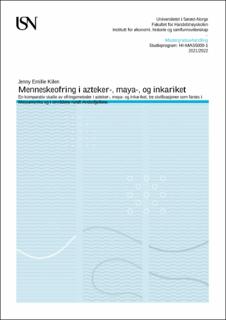| dc.contributor.advisor | Bandlien, Bjørn | |
| dc.contributor.author | Kilen, Jenny Emilie | |
| dc.date.accessioned | 2022-07-09T16:41:32Z | |
| dc.date.available | 2022-07-09T16:41:32Z | |
| dc.date.issued | 2022 | |
| dc.identifier | no.usn:wiseflow:6566672:49842827 | |
| dc.identifier.uri | https://hdl.handle.net/11250/3004307 | |
| dc.description.abstract | Denne avhandlingen vil handle om de tre sivilisasjonene azteker-, maya- og inkariket. Disse kulturene eksisterte i Mesoamerika og i områdene rundt Andesfjellene. Perioden jeg skal forholde meg til er fra 1300-tallet og til spanjolenes erobring på 1500-tallet. Problemstillingen er: Hvilke forskjeller og likheter finnes i de ulike ofringsmetodene som ble tatt i bruk i azteker-, maya- og inkariket, og hvilke faktorer kan forklare hvorfor det ble ofret mennesker?
Jeg skal forsøke å svare på problemstillingen ved og strukturert gå inn på hver av de enkelte sivilisasjonene før jeg går inn i et sammenlikningskapittel. Faktorene som vil bli undersøkt er de religiøse, politiske, sosiale og økonomiske. Gjennom avhandlingen vil jeg vise til ulike måter å ofre på i de tre sivilisasjonene, men mitt hovedfokus er på menneskeofringer.
Avhandlingen vil starte med en innledning som kort forklarer historiografien, hvilke metode jeg har benyttet meg av og hvilke avgrensninger jeg har hatt underveis i skriveprosessen. Etter innledningen vil det komme tre kapitler som tar for seg hver sin sivilisasjon. I de tre kapitlene vil jeg trekke frem mytologien til sivilisasjonen, hvordan samfunnet var og hvilke ofringsmetoder som ble brukt. Aztekerriket, som er kjent for sine blodige ofringer, vil være først ut. Etter aztekerne blir mayariket studert og sist tar jeg for meg inkariket. Etter disse tre kapitlene samler jeg alle de løse trådene og bruker et kapittel til å sammenlikne de tre rikene.
Siden disse sivilisasjonene inneholder en del vanskelige begreper følger det med en begrepsliste med de viktigste ordene for å forstå avhandlingen. Det er også en rekke bilder og illustrasjoner lagt ved som vedlegg for å gi et innblikk i hvordan enkelte gudeskikkelser og seremonier kan ha sett ut. | |
| dc.description.abstract | This thesis will be about the Aztec, Mayan and Inca civilizations. These cultures existed in Mesoamerica and in the areas around the Andes. The period I will focus on is from the 14th century to the conquest of the conquistadors in the 16th century.
The thesis statement is: What differences and similarities exist in the different methods of sacrifice used in the Aztec, Mayan and Inca civilizations, and what factors can explain why humans were sacrificed?
I will try to answer the thesis statement by looking into each one of the civilizations, before I enter a comparison chapter. The religious, political, social, and economic are the factors that will be examined. Through my thesis I will refer to different ways of sacrificing in the three civilizations, but my main focus is on human sacrifices.
The thesis will begin with an introduction that briefly explains the historiography, which methods I have used and what delimitations I have had during the writing process. After the introduction, three chapters that address each civilization will follow. In the three chapters I will highlight the mythology of the civilization, what the society was like and which methods of sacrifice they used. I will begin with the Aztec Empire, which is known for its bloody sacrifices. After the Aztecs, I will focus on the Mayan Empire and then the final civilization I will dive into is the Inca Empire. After these three chapters, I gather all the loose ends and use a chapter to compare the three realms.
Since these civilizations contain some difficult concepts, a conceptual list of the most important words is provided to easier understand the thesis. There are also a number of pictures and illustrations attached, to give an insight into what gods and ceremonies may have looked like. | |
| dc.language | nob | |
| dc.publisher | University of South-Eastern Norway | |
| dc.title | Menneskeofring i azteker-, maya- og inkariket | |
| dc.type | Master thesis | |
